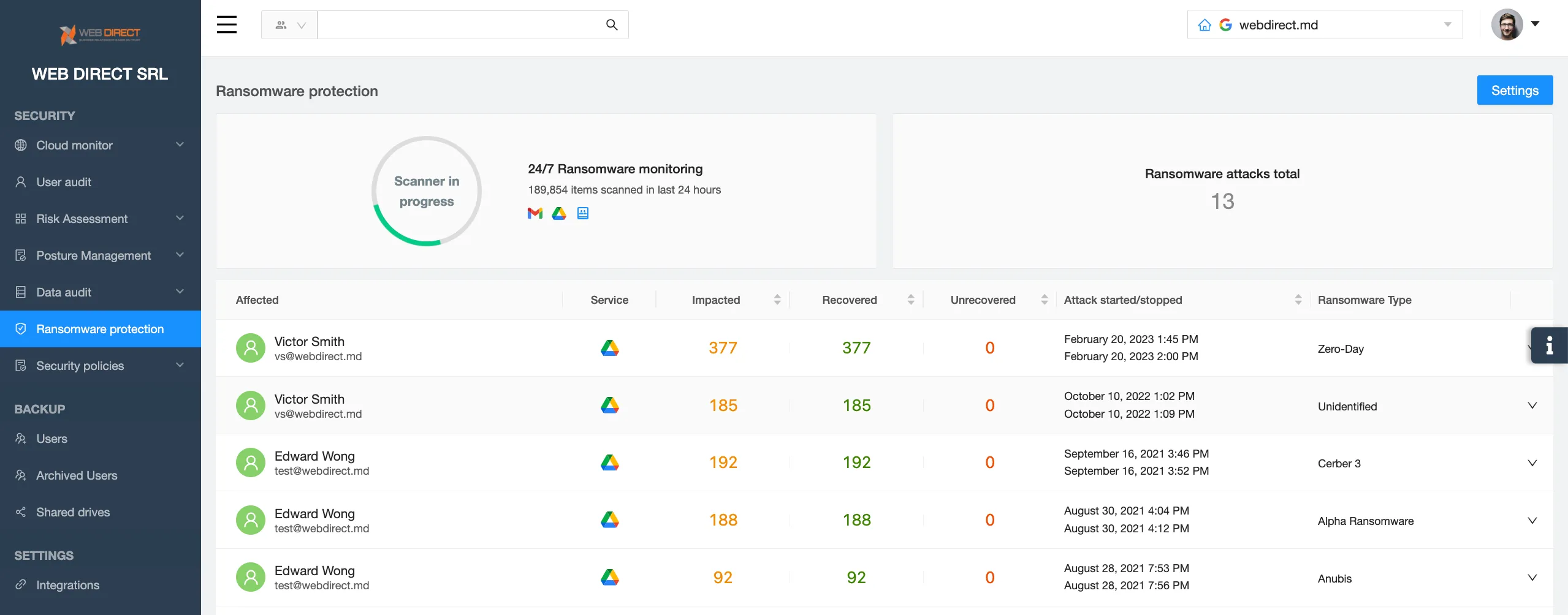The Importance of Disaster Recovery Plans for Businesses
Cybersecurity events can disrupt business operations, have legal implications, cause financial and reputational, and even lead to bankruptcy. To minimize the impact of such incidents, organizations need a Disaster Recovery Plan. In this article, we discuss disaster recovery and the importance of DRP for businesses.
Understanding Disaster Recovery Plans
Cyber incidents encompass many types of incidents from ransomware attacks to account hijacking, to human errors, to zero-day events. It is safe to say that the occurrence of a cyber incident is a matter of time rather than chance. No matter how good the organization’s IT security is, it’s impossible to eliminate all the incidents. That’s why fast and efficient disaster recovery is critical.
Just like any process in an organization, disaster recovery is more efficient with a thorough strategy and plan in hand. A cyber incident can wreak chaos in an organization making people overemotional, vulnerable, and confused. A Disaster Recovery Plan can provide much-needed guidance in a time when it’s hard to think rationally while it’s essential to act quickly and efficiently.
Key components of a comprehensive DRP
There are many approaches to determining the key components of a Disaster Recovery Plan. We suggest categorizing them in five main groups:
- Goals
For each type of disaster, it is important to identify the main goals of disaster recovery and prioritize them. For example, if a company experiences a ransomware attack, its key goals will be identifying and cutting off the attack source, recovery of the data, investigating the reasons of the attack, and determining if cybercriminals stole any data. These are long processes, so the timeframes and priorities should be set for each of them. Goals should be realistic.
- People
It’s critical to form your disaster recovery team prior to the disaster. Each person should know their role and their tasks. Most roles should have a backup executor, if possible.
- Tools
Tools like proactive ransomware protection can significantly speed up the restoration after a cybersecurity incident. Backups are essential for data recovery processes. That’s why a Disaster Recovery Plan must contain a list of tools and their capabilities.

- Steps
This part of the Disaster Recovery Plan provides clear guidelines of what actions should be taken after a cyber incident and in what order. It can also specify the roles and the tools and explain which goals a certain action helps to achieve.
- Budget
The budget should include the costs of disaster and disaster recovery, tools, possible overtime of employees, company downtime, etc. It should also provide ways to minimize these costs if possible.
Learn how to calculate disaster recovery costs.
The Impact of Disasters on Businesses
The impact of cybersecurity incidents on business can range from negligible to devastating. Many employees have made errors that led to data loss or data corruption. In such cases, one can either retrieve data from the backup or work overtime to recover the lost information. However, a company-wide data loss can lead to significant downtime and even termination of operations.
Here are the major consequences of a cybersecurity incident for a business.
Downtime
Downtime is the period when certain resources and tools in the organization are unavailable for use. As a result, employees of the organization cannot perform their duties, and business operations are interrupted.
Many cybersecurity incidents cause downtime due to their impact on data and/or IT environments. The duration of downtime depends on the type of the incident, its impact on the IT system and data, and the disaster recovery capabilities.
The downtime can last from several hours to several months. It can impact all the organizational units or only some of them.
Financial losses
There are several financial losses associated with the cybersecurity incident. First, the business loses money due to the downtime. While continuing to pay salaries, overhead costs, and operating costs, the business struggles to operate at its usual rate (or function at all) and generate new income.
Second, the hackers can extract money from the organization. For example, a ransomware gang can demand payment in exchange for the decryption key.
Third, the company can hire an outsourcing company or additional IT specialists to manage the disaster recovery because the impact of the disaster surpasses their IT team’s capabilities.
Fourth, businesses can be forced to pay legal fees and penalties resulting from the cybersecurity event. For example, clients can sue the business for data leakage. Alternatively, the state can charge for non-compliance (e.g., certain data is subject to retention).
Fifth, the loss of existing or potential paying clients. This is especially critical for subscription-based businesses. Since their revenue depends on seamless continuous operations, once it’s over the clients unsubscribe and search for the same service elsewhere.
Reputational damage
Up to 83% of US customers will readily leave the company after a security breach, and 21% will never return. However, the loss of clientele is not the only problem for a business. Customers can leave poor reviews on various platforms and express their dissatisfaction with the business on social media platforms.
The information about a cybersecurity incident can leak to the mass media and impact the decisions of potential clients, existing and potential partners, and investors.
Reputational damage is especially critical if the cyber event includes data leakage.
Legal and regulatory implications
In many countries, including the US, the laws regulate the digital data. Its loss or exfiltration can be subject to legal penalties. The state punishes the victim of a cybersecurity incident for failure to provide necessary protection.
Impact on employees
Like any disruption, cybersecurity incidents have a negative impact on employees. It is especially critical in case of cyber attacks since employees can experience them similarly to victims of regular crime.
Your team can feel confused, frustrated, and unsafe. Many employees can leave the company during an extensively long cybersecurity incident doubting the company can survive the crisis.
Cybersecurity disasters can impact employee productivity and mental health.
Benefits of Implementing Disaster Recovery Plans
In this section, we discuss the benefits of a Disaster Recovery Plan for the organization.
- Minimizing downtime and maintaining business continuity
As mentioned above, cybersecurity incidents can impact your IT team’s ability to act efficiently and rationally. Without a plan, your team will have to figure out on their own what to do and how to do it. They will be prone to mistakes and will find it hard to quickly provide the best solution to the problem. In a way, they’ll be inventing the wheel. Additionally, the team might lose time arguing about the possible solutions and their efficiency.
DRP helps tackle all these problems minimizing downtime.
- Reducing costs
Shorter downtime will reduce the financial losses associated with the disaster.
- Preserving customer trust and brand reputation
Faster recovery will also reduce the client churn rate and reputational losses. Some companies can even turn it into a success story.
FAQ
What is the most important goal of disaster recovery?
The most important goal of disaster recovery is to ensure the continuity of critical business operations and minimize downtime in case a disruptive event or disaster occurs. This also includes recovering and restoring IT systems, data, and infrastructure and allowing an organization to resume its essential functions with minimal disruption.
Why is disaster planning important?
Disaster planning is highly important to an overall business continuity strategy. First, it helps minimize the negative consequences for an enterprise in case of a system breakdown or downtime.
Second, disaster recovery planning is a requirement of many data privacy and security laws and standards, like HIPAA, GDPR, SOC2, etc. In contrast, failure to follow a disaster recovery plan can result in steep fines and serious compliance violations.
Finally, a robust disaster recovery plan helps businesses to recover quickly from any disaster event and prevents a company from suffering a massive data loss, reduced productivity, out-of-budget expenses, and reputational damage that, in turn, can lead to lost customers and revenue.
What is the most important component of a disaster recovery plan?
No single component of the disaster recovery plan is more important than others. Instead, there are several elements, that, if applied in complex, can result in an effective and efficient disaster recovery plan. These key components include:
- Assigning a disaster recovery team responsible for developing, implementing, and maintaining the plan.
- Conducting a risk assessment to identify risks related to natural disasters, technology incidents, and man-made emergencies.
- Determining critical assets to focus on for primary survivability.
- Establishing backup and recovery procedures that identify what to back up, how, by whom, where to store the backup, and how frequently backups should occur.
- Ensure continuous testing and maintaining the disaster recovery plan to evaluate the procedures documented for effectiveness and appropriateness as risks of emergencies are always changing.
What are the benefits of implementing a disaster recovery plan for businesses?
Implementing and maintaining a disaster recovery plan is highly beneficial for businesses. Here are some of the benefits:
- cost efficiency (ensuring continuity of critical business operations and minimizing downtime in the event of a disaster can potentially save organizations a lot of money).
- customer retention (disaster recovery planning enables businesses to maintain acceptable service quality, even if a disaster occurs, and helps retain customers).
- business resilience (disaster recovery planning streamlines IT processes, helps eliminate redundant hardware and reduces the risk of human error. So, it is not only about disaster recovery but also about making your business more resilient and profitable).
How often should a DRP be tested and updated?
The frequency of testing and updating a disaster recovery plan depends on various factors, including the organization’s size, industry, regulatory requirements, and the pace of technological, operating software, and human resource changes. However, it is generally recommended to conduct tests and updates at least once a year.
Was this helpful?
How Can You Maximize SaaS Security Benefits?
Let's get started with a live demo
Latest blog posts
Brewing Trouble: How a Starbucks Ransomware Attack Poured Cold Wate...
Cybercriminals often carry out attacks around holidays as this helps to ensure the most amount...
How to Recover Deleted Messages from Microsoft Teams
In modern-day hybrid and remote work environments, collaboration and communication tools like Microsoft Teams are...
Data Loss Prevention Techniques for 2025 and Beyond
It’s painstakingly clear that data loss is a major challenge facing businesses today. Our experts...


